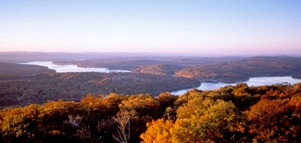
Trolling is popular on lakes throughout the Mid Atlantic region. Lake trolling can be effective for catching landlocked striped bass, northern pike, musky, Atlantic salmon, Chinook salmon, coho salmon, steelhead, brown trout, lake trout, and other species.
Lake trolling techniques can be characterized by water depth, equipment type, and lure or bait selection. In many cases, the type of gear used, depths covered, and species targeted will be dictated by factors that affect each lake.
Occasionally, anglers troll near the surface, covering depths from zero to perhaps 10 feet. To troll near the surface, very little special tackle is required. For situations that require many lines, planer boards or outriggers are usually required.
To cover a range of depths, lake trollers use a variety of equipment. Downriggers dominate the fishing on some lakes, especially when salmon, steelhead, and lake trout are present.
Downriggers allow the use of light tackle over a wide range of depths. Although they work well at mid-depths, downriggers are not well suited for near-bottom fishing.
Wire line fishing is popular in some fisheries. Depending on conditions and angler preference, anglers may use single strand stainless steel, monel or copper wire, or multi-strand cable. Several of the newer micro-braided lines are also used for lake trolling.
When trolling in deep water, anglers use a combination of heavy lines, weights, and speed control. In general, as the length of line that is let out increases, so does the lure depth.
In some areas, wire or braided lines have a slight advantage over downriggers as they can be rigged to bounce along the bottom. Despite its advantages, deep trolling with wire or braided lines can be a challenge for anglers.
Planers can also be used for deep trolling in lakes. These devices come in a number of configurations. Planers work like an airplane wing, diving as boat speed is increased. Most freshwater models attach to the line several feet in front of the lure.